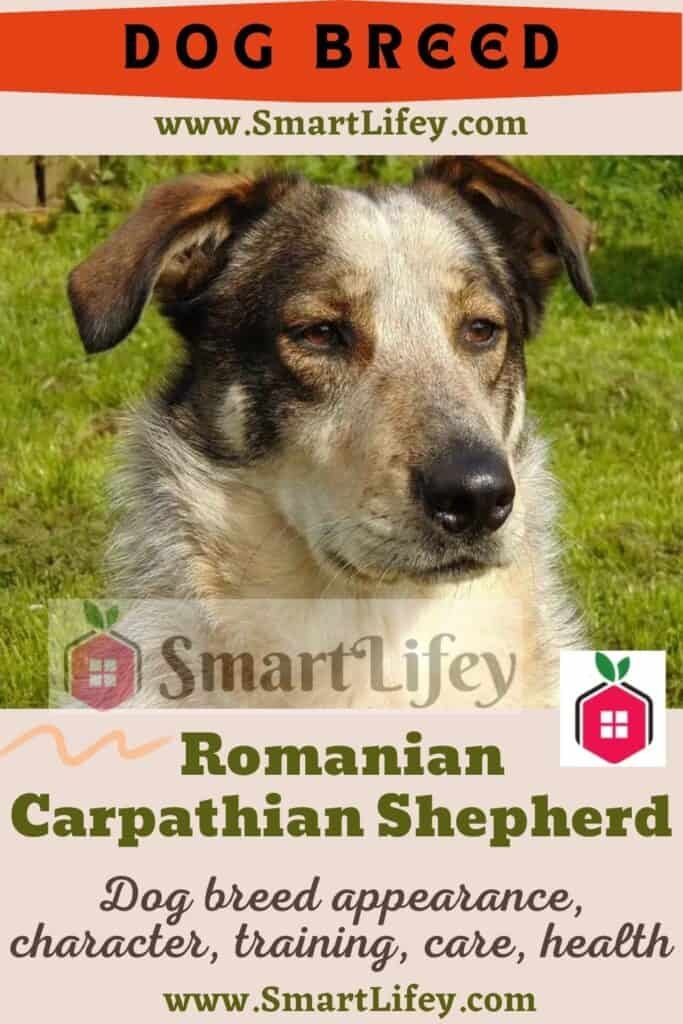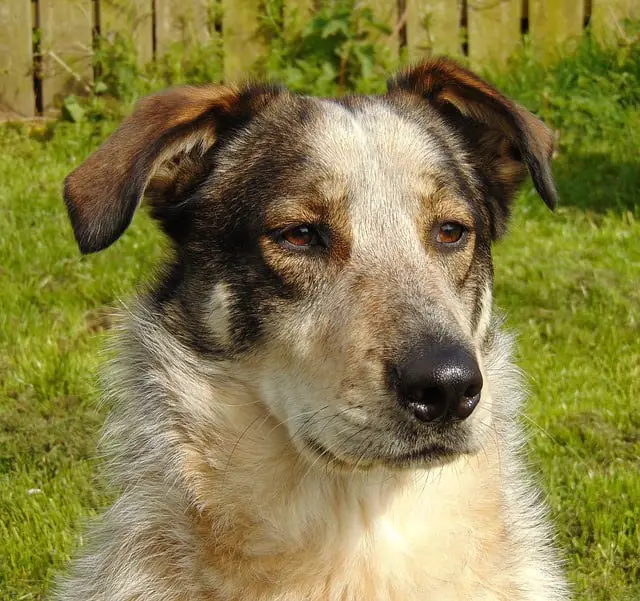
The Romanian Carpathian Sheepdog or Carpathian breed is characterized by its large size and by being an innate and courageous guardian. Sticking its character affectionate and unconditional to herds and to its master. Inside the home, it is a dog with a dignified, calm, obedient and balanced behaviour. At Petlifey, we explain everything about the Carpathian shepherd.
Character of the breed Romanian Carpathian Shepherd
One of the most characteristic signs of the Romanian Carpathian Shepherd, also known familiarly as “carpathian”, is its fierce and indomitable character, which makes them an extraordinary guard dog.
Together with its master, it is a dog with a calm, calm and observant temperament, but when faced with any external threat, its behaviour is that of a true warrior who will even be able to give its life to defend its flock and its entire family. This is the innate character of the Romanian Carpathian shepherd, which has remained intact for centuries, because only thanks to them could survival be guaranteed in an area as problematic and extensive as the valleys located between the Carpathian mountain system and the riverbanks. from the Danube, an area full of forests plagued by wolves, bears and numerous cattle thieves.
In this context, the Romanian shepherd of the Carpathians, with a courage that knows no limits, gives its life to defend its own, and the shepherds appreciate them greatly because, in addition to being very effective, it is obedient and very loyal.
- Energy: High level. You need to take long walks every day and enjoy frequent doses of freedom.
- Temperament: Innate guardian, it is vigilant, warrior, fierce and very brave. With its master it is calm, balanced and very loyal, and with the herds, instinctive and unconditional.
- Adaptability: Low. It does not adapt well to city life, since its natural habitat is the countryside and large open spaces where it can run freely.
- Sociability: Low. Despite getting along very well with all members of the house, be they people or animals, it does not tolerate strangers, with whom it can even be aggressive.
- Health: Good. There are no serious diseases associated with the breed.
- Longevity: Low. It usually lives between 8 and 10 years, like almost all dogs of this size.
- Utility: Versatile. It is above all a shepherd, guard and defence dog. But it also regularly collaborates with the army and the police.
- Use: grazing, surveillance and guarding.
Is it a good family dog?
Despite its strong character, this does not mean that it is an animal that is difficult to coexist with, because although it is a wild beast, at home it is a stuffed animal and its relationship with all the members of the family is excellent. The situation is complicated by the arrival of strangers to the home, since it does not tolerate them.
Is it a beginner dog?
Due to its fierce and courageous character, the Carboard is not a suitable dog for any master. Its owner must be someone seasoned and experienced in the handling and education of dogs with a lot of temperament.
Can you live in an apartment or in the city?
As the natural habitat of this breed is the field and wide open spaces, and its main function is the guardian and watchdog of the cattle, it is genetically prepared to travel large areas and therefore needs to take long walks every day and enjoy many doses. of freedom. Therefore, this is not a good city dog.
Characteristics of the Romanian Carpathian Shepherd
The physical appearance of the Carpathian shepherd is that of a dog with a rectangular body and large dimensions, its general appearance is that of a powerful, vigorous and agile dog, never heavy.
Despite being quite large, it is agile and vigorous. It has a slightly rectangular body, with a broad and slightly sloping rump. Males are visibly taller and bulkier than females.
What is the Romanian Carpathian Shepherd breed physically like?

Body
It is a large, strong dog with a rectangular body structure, since the length of the body is greater than the height at the withers, which is about 69 cm in males and about 63 cm in females. The skeleton is strong, and the body is quite muscular.
Their feet are solid, oval in shape and well developed, although the hind feet are somewhat smaller. The fingers are arched, and the pads are elastic and resistant.
The tail is bushy and with abundant hair, it is of high implant. It reaches the point of the hock and the dog usually wears it low and straight, or in the shape of a saber. In action it lifts it.
The movement is loose, with a good reach. The limbs move in parallel planes, and the trot is vigorous and sustained.
Head
Its head structure is strong but not heavy, it is similar to that of the wolf. The stop is moderate, and the muzzle, powerful, quite long and somewhat oval, ends in a broad, black nose.
The eyes are almond-shaped, not very large compared to the head as a whole, and are usually dark in color, with black eyelids.
Their ears are triangular, of medium size and with a rounded tip. Set a little higher than the eyes, they fall close to the cheek.
Coat and color
The hair is of moderate length and abundant over the entire body, with the exception of the head and the inner sides of the extremities, where the hair is short and straight.
On the neck, the back of the limbs and the tail, the hair is longer and very abundant. In general, the outer coat is rough, dense and stretched while the inner coat is also dense but soft.
The specimens of this breed are usually of a charcoal sand color (dark bay) but with different shades, often more visible on the lateral parts and darker on the upper part of the trunk.
As for the color of the Carpathian shepherd, there are individuals that are also charred sand color but with white markings, generally not very widespread.
Breed standard Romanian Carpathian Shepherd
- Origin: Romania.
- Other names: Romanian Carpathian Shepherd Dog / Berger roumain des Carpathes / Ciobanesc Romanesc Carpatin.
- Size: Very large.
- Height at the withers: between 65 and 73 cm for males, and between 59 and 67 cm for females.
- Weight: between 40 and 45 kg for males, and between 35 and 40 kg for females.
- Head: It is of the lupoid (wolf) type, that is, similar to that of the wolf. Strong, but not heavy, its forehead is broad and slightly bulging.
- Skull: It is wider between the ears and progressively tapers towards the stop.
- Nose-frontal depression (stop): It is moderate, neither too marked, nor elusive.
- Muzzle: Powerful, it has an oval and somewhat conical profile. The length of the muzzle is almost the same as that of the skull.
- Nose: It is large, wide and black in color.
- Jaws: They are strong, solid and straight, with powerful teeth. The bite is scissor.
- Eyes: Almond-shaped and slightly oblique, not too large in relation to the dimensions of the skull. They are dark in color and have black eyelids.
- Ears: Set slightly higher than the eye line, triangular, not too large and close to the cheeks. The end is slightly rounded.
- Neck: Muscular, powerful and of moderate length, it forms an angle of about 50 ° in relation to the horizontal.
- Body: The body is vigorous, well developed and slightly rectangular.
- Back: It is of medium length, straight, solid and muscular.
- Chest: Fairly broad, well developed and slopes well to elbow level. Ribs are solid and well arched, never barrel-shaped.
- Tail: Set high, bushy and abundant fur. If the dog is at rest, it is low, straight or slightly saber-shaped, and descends to the point of the hock. But when he’s attentive or in action, it lifts her even above back level.
- Forelimbs: The front legs have strong bones, are plumb and stand practically straight, that is, perpendicular to the ground.
- Shoulders: Moderately sloping and solid.
- Forearms and arms: Straight, they are very vigorous and with an oval profile.
- Hind limbs: Hind legs are muscular, with solid bones and good angulation.
- Legs: They are wide and well poised.
- Hocks: They are solid and firm, neither too high nor too sloping.
- Feet: Oval, solid and well developed, the feet are compact. The posterior ones are somewhat smaller than the previous ones. They have arched and close-knit toes, and resilient, elastic pads.
- Hair: Coarse, dense and drawn, abundant all over the body, very dense and of moderate length. It has dense and smooth undercoat.
- Color: It is brownish sand color, with different shades.
- FCI Classification : FCI No. 350. Group 1 – Sheepdogs and Cattle Dogs (except Swiss Cattle Dogs). Section 1 – Sheepdogs.
